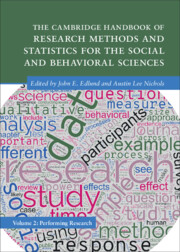 The Cambridge Handbook of Research Methods and Statistics for the Social and Behavioral Sciences
The Cambridge Handbook of Research Methods and Statistics for the Social and Behavioral Sciences Book contents
- The Cambridge Handbook of Research Methods and Statistics for the Social and Behavioral Sciences
- Cambridge Handbooks in Psychology
- The Cambridge Handbook of Research Methods and Statistics for the Social and Behavioral Sciences
- Copyright page
- Dedication
- Contents
- Figures
- Tables
- Contributors
- Preface
- Part I Quantitative Data Collection Sources
- 1 Student Samples in Research
- 2 Mechanical Turk: A Versatile Tool in the Behavioral Scientist’s Toolkit
- 3 Social Media Research
- 4 Prolific: Crowdsourcing Academic Online Research
- 5 Field Research
- 6 Organizational Research
- 7 Integrating Culture in Research
- 8 Mixed Methods and Multimethod Research
- Part II Important Methodological Considerations
- Part III Self-Report Measures
- Part IV Behavioral Measures
- Part V Physiological Measures
- Part VI Qualitative Data Collection Sources
- Index
- References
3 - Social Media Research
from Part I - Quantitative Data Collection Sources
Published online by Cambridge University Press: 12 December 2024
- The Cambridge Handbook of Research Methods and Statistics for the Social and Behavioral Sciences
- Cambridge Handbooks in Psychology
- The Cambridge Handbook of Research Methods and Statistics for the Social and Behavioral Sciences
- Copyright page
- Dedication
- Contents
- Figures
- Tables
- Contributors
- Preface
- Part I Quantitative Data Collection Sources
- 1 Student Samples in Research
- 2 Mechanical Turk: A Versatile Tool in the Behavioral Scientist’s Toolkit
- 3 Social Media Research
- 4 Prolific: Crowdsourcing Academic Online Research
- 5 Field Research
- 6 Organizational Research
- 7 Integrating Culture in Research
- 8 Mixed Methods and Multimethod Research
- Part II Important Methodological Considerations
- Part III Self-Report Measures
- Part IV Behavioral Measures
- Part V Physiological Measures
- Part VI Qualitative Data Collection Sources
- Index
- References
Summary
The purpose of this chapter is to review the contemporary methods used to collect and examine data on social media and to explore the common pitfalls of internet research. The discussion focuses on the importance of internet research while also reviewing common practices of data retrieval (e.g., crowdsourcing and snowball sampling). We will also explain a commonly used tool to analyze data collected using social media. Specifically, one section is dedicated to the Linguistic Inquiry and Word Count software (LIWC); another section focuses on a brief overview of machine learning (ML) techniques and data visualization. At the end of the chapter, we will also examine some common ethical concerns, focusing mainly on anonymity and privacy, while also giving a general overview on the European General Data Protection Regulation (GDPR). Future directions for social media will then be addressed.
- Type
- Chapter
- Information
- The Cambridge Handbook of Research Methods and Statistics for the Social and Behavioral SciencesVolume 2: Performing Research, pp. 48 - 71Publisher: Cambridge University PressPrint publication year: 2024
